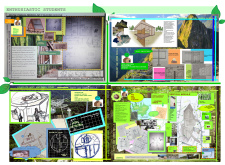5 key facts about this project
The design focuses on creating flexible living spaces that prioritize ecological values. Located near the Machu Picchu archaeological park, it aims to connect inhabitants with the natural surroundings. The project encourages personal interaction with the environment while offering practical and adaptable living solutions that respond to various needs.
Modularity and Adaptability
The concept of modularity is central to the design, allowing residents to modify their spaces according to their requirements. The ground floor includes a mini greenhouse designed for studying local plants. This feature not only supports sustainability but also serves as a space for physical activity or gardening. The design successfully addresses multiple uses without sacrificing the overall integrity of the living area.
Spatial Fluidity
Distinct architectural elements, such as bamboo partitions and revolving mezzanines, create a feeling of open, adaptable space. These features enable the living areas to change as needed, promoting a sense of connection between different parts of the home. This adaptability fosters innovation in how residents engage with their environments, allowing for varied experiences within a single footprint.
Material Selection
Material choices reflect a commitment to durability and environmental care. Load-bearing stone walls with a reinforced concrete core provide strength, while limestone slabs on the outside enhance thermal efficiency and visual appeal. The design includes granite finishes in the bathrooms for a sturdy, polished look, while stained glass along the perimeter invites natural light into the interior. Teak wooden flooring adds warmth, and a concrete roof protects against weather elements, ensuring long-lasting resilience.
The architecture emphasizes a thoughtful integration with nature, where each component plays a role in enhancing the living experience. One unique aspect is the inclusion of living cells that facilitate stargazing, inviting residents to connect with the night sky. This attention to detail creates a home that not only serves its functions but also enriches the lives of those who inhabit it.



















































